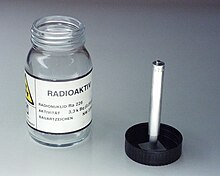
Back Activitat d'una substància radioactiva Catalan Měrná aktivita Czech Activité massique French 比放射能 Japanese
This article may be too technical for most readers to understand. (January 2014) |
| Activity | |
|---|---|
 Ra 226 radiation source. Activity 3300 Bq (3.3 kBq) | |
Common symbols | A |
| SI unit | becquerel |
Other units | rutherford, curie |
| In SI base units | s−1 |
| Specific activity | |
|---|---|
Common symbols | a |
| SI unit | becquerel per kilogram |
Other units | rutherford per gram, curie per gram |
| In SI base units | s−1⋅kg−1 |
Specific activity (symbol a) is the activity per unit mass of a radionuclide and is a physical property of that radionuclide.[1][2] It is usually given in units of becquerel per kilogram (Bq/kg), but another commonly used unit of specific activity is the curie per gram (Ci/g).
In the context of radioactivity, activity or total activity (symbol A) is a physical quantity defined as the number of radioactive transformations per second that occur in a particular radionuclide.[3] The unit of activity is the becquerel (symbol Bq), which is defined equivalent to reciprocal seconds (symbol s-1). The older, non-SI unit of activity is the curie (Ci), which is 3.7×1010 radioactive decays per second. Another unit of activity is the rutherford, which is defined as 1×106 radioactive decays per second.
The specific activity should not be confused with level of exposure to ionizing radiation and thus the exposure or absorbed dose, which is the quantity important in assessing the effects of ionizing radiation on humans.
Since the probability of radioactive decay for a given radionuclide within a set time interval is fixed (with some slight exceptions, see changing decay rates), the number of decays that occur in a given time of a given mass (and hence a specific number of atoms) of that radionuclide is also a fixed (ignoring statistical fluctuations).
- ^ Breeman, Wouter A. P.; Jong, Marion; Visser, Theo J.; Erion, Jack L.; Krenning, Eric P. (2003). "Optimising conditions for radiolabelling of DOTA-peptides with 90Y, 111In and 177Lu at high specific activities". European Journal of Nuclear Medicine and Molecular Imaging. 30 (6): 917–920. doi:10.1007/s00259-003-1142-0. ISSN 1619-7070. PMID 12677301. S2CID 9652140.
- ^ de Goeij, J. J. M.; Bonardi, M. L. (2005). "How do we define the concepts specific activity, radioactive concentration, carrier, carrier-free and no-carrier-added?". Journal of Radioanalytical and Nuclear Chemistry. 263 (1): 13–18. doi:10.1007/s10967-005-0004-6. ISSN 0236-5731. S2CID 97433328.
- ^ "SI units for ionizing radiation: becquerel". Resolutions of the 15th CGPM (Resolution 8). 1975. Retrieved 3 July 2015.